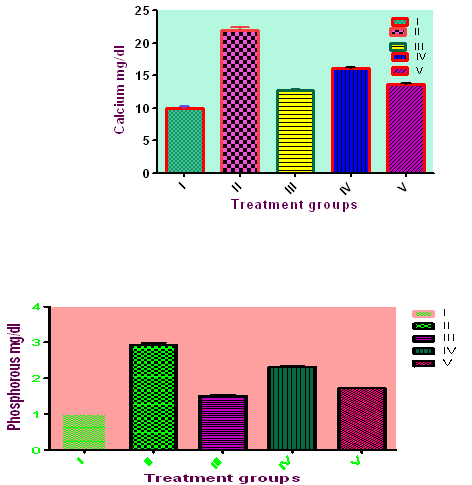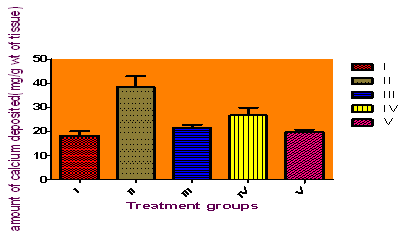About Authors:
*SOUMYA G., SRINIVAS S., NAVEEN KUMAR M., KRISHNA MOHAN C.
Department of Pharmacology,
St. John College of Pharmacy, Warangal,
Andhra Pradesh, India-5067371.
*sre_varma123@yahoo.co.in
Introducion:
Kidney stone formation or urolithiasis is a complex process that is a consequence of an imbalance between promoters and inhibitors in the kidneys. Even though the technological developments in the present medical practice the formation and growth of renal calculi continues to afflict humankind. Though various kinds of stone have been identified, calcium stones are the most common in human as well as rats. The rat experimental models of Calcium oxalate urolithiasis, induced by ethylene glycol alone, or in combination with other drugs such as ammonium chloride are often used to study the pathogenesis of kidney crystal deposition. The urolithiasis was induced by administration of gentamycin and calculi producing diet (5% ammonium oxalate in standard rat pellet feed) for 28 days to rats’ results in hyperoxaluria, Calcium oxalate crystalluria, and occasional deposition of CaOx crystals in the kidney.
Reference Id: PHARMATUTOR-ART-1443
MATERIALS AND METHODS
Plant material
The plant of Isapgolwere collected from the surroundings of Chittor Disrict, Andra Pradesh and authenticated by Dr. K. Madhava chetty Department of Botany, Sri Venketeswara Univerisity.
Preparation of Methanolicextract
The plant of Isapgol were cleaned and chopped into small pieces and dried under shade. Thecoarse powder by mechanical grinding. The powdered material 100 g was subjected to continue hot extraction in soxhlet apparatus at a temperature of (60- 700 c) by using Methanol (95% v/v). After complete extraction, the extract was dried. The yield was about 5% w/w and it was stored at 4oC in desiccator. The extract was diluted with 5ml of dimethylsulphoxide as suspending agent for oral administration to animals.
Selection of the dose
The LD50 value of methanolic extracts Isapgol of plant has been reported. Hence, one 10th of LD50 dose was taken as a therapeutic dose for determination of antiurolithiatic effect.
Experimental animals
Male albino rats of Wistar rats weighing between 150-200g were used. The animals were fed with commercial rat feed pellets and were given water ad libitum. The animals were acclimatized and maintained at 240C and 12h/12h light dark cycle and were kept in polypropylene cages in a well-ventilated room under hygienic conditions throughout the study.
Drugs
Gentamycine was procured from Ranbaxy, India. All other chemicals used are of analytical grade and obtained from S.D. Fine Ltd., India.
Antiurolithiatic studies- calcium oxalate stones
Hyperoxaluria and calcium oxalate deposition in the kidney was induced using gentamycine (40 mg/kg/s.c) and calculi producing diet (CPD). The latter was made from powdered standard rat pellet feed (Hindustan liver Ltd., Bombay, India) mixed with ammonium oxalate (5%), then made into pellets and dried.
Pharmacological screening for anti urolithiatic activity
Animals were divided into five groups, each containing six animals. Group I served as normal control and maintained on regular laboratory diet and water ad libitum. Group II to V were fed with gentamycine and calculi producing diet (5% ammonium oxalate in standard rat pellet feed) in standard rat pellet for induction of renal calculi till1-28th day. Group III received standard antiurolithiatic drug cystone (750 mg/kg body weight) from 15th to 28th day. Group IV served as curative regimen, received methanolic extract of the plant of Isapgol at a dose of 400 mg/kg, body weight from 15th day to 28th day respectively. Groups V served as preventive regimen received methanolic extract of the plant of Isapgol at a dose of 400 mg/kg body weight from 1st day to 28th day respectively. Both the extracts were administered once daily by oral route.
Antiurolithiatic activity: gentamicine and CPD induced urolithiatic model
Assessment of urinary parameters
The rats were hydrated with 5ml of distilled water (p.o) and placed in separate metabolic cages and 24hr urine samples were collected. Urine samples were collected from Normal, Curative and Preventive groups after 28 days interval and at the end of the experimental period.The collected urine was analyzed for calcium and using standard methods. The volume of urine collected from all groups was recorded. Further microscopy of the urine was performed.
Kidney homogenate analysis
At the end of experimental period, the rats were sacrified and kidneys were carefully removed, washed in ice cold 0.15M KCl and their weights were recorded. One kidney was homogenized in 10% Hcl. The homogenate was centrifuged at 2500 rpm and supernatant was used for estimating calcium and phosphorus.
Statistical analysis
Results are expressed as mean ± SEM. Statistical analysis was carried out using one-way ANOVA followed by Bonferroni’s Multiple Comparison test. Differences between the data were considered significant at P<0.05.
NOW YOU CAN ALSO PUBLISH YOUR ARTICLE ONLINE.
SUBMIT YOUR ARTICLE/PROJECT AT articles@pharmatutor.org
Subscribe to PharmaTutor Alerts by Email
FIND OUT MORE ARTICLES AT OUR DATABASE
RESULTS
Antiurolithiatic study
Preliminary phytochemical investigations
On preliminary phytochemical investigations using qualitative chemical tests, the extract revealed the presence of steroids, flavonoids, and coumarins.
Urinary excretion of calcium and phosphorous
A significantly (p<0.001) increase in the urinary excretion of calcium and phosphorus in inducer control group-II animals when compare to the group-I animals. Whereas the standard treated group animals was shown significantly (p<0.01) decrease in calcium excretion when compared to the control animals. Similarly a significantly in Isapgol treated animal at the dose level 400mg/kg.

Deposition of calcium and phosphorus in kidney
The effect of ethanolic extract of Isapgol on deposition of calcium and oxalate in the kidney. On supplementation of Isapgol a dose dependent significant reduction in the gentamicin induced renal deposition of calcium and phosphorus was observed in the groups II and VI rats. In both the treated groups preventive and curative doses of Isapgol ( 400mg/kg) exhibited effective decrease in both calcium and oxalate deposition in the kidneys when compared to the groups that received low dose of Isapgol thus indicating the dose related effect of Isapgol.

Kidney weights
On administration gentamicin in standard rat pellet feed was powdered and mixed with ammonium oxalate (5%) for 15 days, a significant increase in the kidney weight was observed in the control rats when compared to the normal rats. There was a prominent decrease in kidney weights in the animals treated with dose of Ispagol (400mg) in the preventive and curative treated groups when compared to their respective controls thereby, indicating a dose related response.

DISCUSSION
Urolithiasis refers to accretion of hard, solid, non-metallic minerals in the urinary tract. It can be traced to the earliest antiquity of human history. A decrease in urine volume and increase in urinary oxalate excretion are found to be the risk factors and hypercalciuria contributes little to calcium stone formation. The diagnosis of urolithiasis is largely dependent on analyzing the clinical presentation and physical examination.
Various animal models have been proposed to induce urinary stones in experimental animals by numerous investigators from time to time. These include calculi producing diet, drug induced and foreign body insertion models. But there has been only limited success in developing an ideal model of renal stone disease that faithfully mimics human urolithiasis.
On the administration of gentamicin and CPD as increase in deposition of calcium and oxalate was observed. Administration of methanolic extract of Isapgol significantly reduced both calcium and phosphorus deposition in the kidneys of both calcium and phosphorus deposition in the kidneys of both preventive and curative groups when compared to their respective controls in both given doses. In the present study, a significant increase in urinary excretion of calcium and oxalate was observed along with the formation of calcium oxalate type of stones. Urinary oxalic acid forms complexes with multiple cationic salts to form oxalate salts. Oxalate salts are soluble when formed with magnesium but when complexed with calcium forms insoluble calcium oxalate thus causing crystalline precipitation of renal calculi of calcium oxalate. Treatment with methanolic extract of Isapgol markedly reduced the excretion of calcium and oxalate in both preventive and curative groups.
There is still a large scope for plant drugs in the treatment of urolithiasis as the modern drugs include side effects on long term use. Chemical and pharmacological studies on the isolated active components of Isapgol may be rewading.
CONCLUSION
Results of our study suggest that Isapgol, can be an alternative or an adjunctive measure to other therapies to prevent CaOx stone formation. The protective effects of EAI against CaOx stone formation and hyperoxalurian induced oxidative stress may be attributed to its saponin and flavonoid principles. However, further phytochemical and pharmacological investigations on Isapgol are necessary to identify the antiurolithiatic and antioxidant chemical constituents that alleviate CaOx urinary stone disease.
References:
1. Moe, O. W. (2006): Pathophysiology and medical management, Lancet 367 pp. 333-344. Asplin, JR., Favus, MJ. and Coe, FL. (1996): Nephrolithiasis. In:
2 Ansari, MS., Gupta, N.P. (2003): Impact of socioeconomic status and medical management of urinary stone disease. Urol Int. 70 (4): 255-61.
3. Amine Laroubi, Mohammed Touhami, Loubna Farouk and Rachida Aboufatima. (2007): Prophylaxis effect of Trigonella foenum graceum L. seeds on renal stone formation in rats. Phytotherapy. Res. (21): 921-925.
4. Crossland, J. (1980): Lewis pharmacology, Churchill Livingstone, New york.: pp 137.
5. Kokate C K, Purohit A P, and Gokhale S B, Text book of Pharmacognosy; Nirali prakashan 2008:105-108.
NOW YOU CAN ALSO PUBLISH YOUR ARTICLE ONLINE.
SUBMIT YOUR ARTICLE/PROJECT AT articles@pharmatutor.org
Subscribe to PharmaTutor Alerts by Email
FIND OUT MORE ARTICLES AT OUR DATABASE











.png)

